MERCEDES-BENZ CLA COUPE 2019 Service Manual
Manufacturer: MERCEDES-BENZ, Model Year: 2019, Model line: CLA COUPE, Model: MERCEDES-BENZ CLA COUPE 2019Pages: 330, PDF Size: 52.4 MB
Page 41 of 330
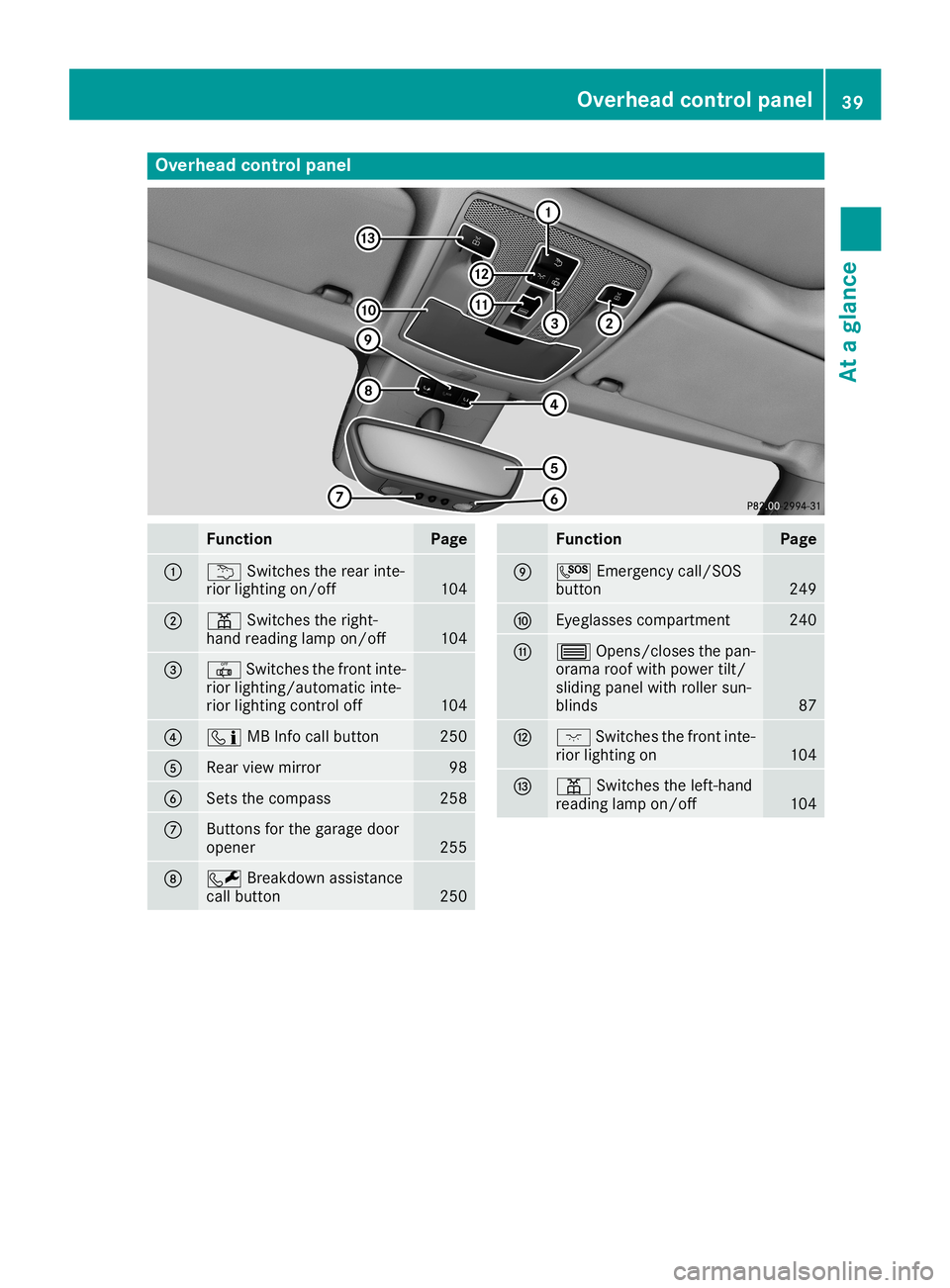
Overhea
dcontrol panel Function Page
0043
0042
Switchestherear inte-
rior lighting on/off 104
0044
003D
Switchestheright-
hand reading lampon/off 104
0087
0033
Switchesthefron tinte-
rior lighting/ automatic inte-
rior lighting control off 104
0085
00D9
MBInfocall button 250
0083
Rear
viewmirror 98
0084
Set
sthe compass 258
006B
Butt
ons forthe garage door
opener 255
006C
0052
Breakdown assistanc e
call button 250 Function Page
006D
0053
Emergencycall/SO S
button 249
006E
Eyeglasses
compartment 240
006F
0057
Opens/ closesthepan-
orama roofwith power tilt/
sliding panelwithroller sun-
blinds 87
0070
004A
Switchesthefron tinte-
rior lighting on 104
0071
003D
Switchestheleft- hand
reading lampon/off 104Overhea
dcontrol panel
39Ataglance
Page 42 of 330

Panic
alarm X
To activate: pressandhold the
0033 button 0043for approx. onesecond.
A visual andaudib lealarm istriggered ifthe
alarm system isarmed.
X To deactivat e:press 0033button 0043again.
or X Insert theSmartK eyinto theignition lock.
or, invehicles withKEYLE SS-GO start- function
or KEYLE SS‑GO
X Press theStart /Stopbutton.
The SmartK eymust beinthe vehicle. Occupant
safety Introduct
iontothe restr aintsystem
The restraint systemcanreduce therisk ofvehi-
cle occupants comingintocont actwith parts of
the vehicle's interiorinthe event ofan accident.
The restraint systemcanalso reduce theforces
to which vehicle occupants aresubjected during
an accident.
The restraint systemcomprises:
R Seat beltsystem
R Air bags
R Child restraint system
R Child seatsecuring systems
The componen tsof the restraint systemworkin
conj unction witheach other. Theycanonly
deploy theirprotect ivefunct ionif,at all times, all
vehicle occupants:
R have fastened theirseatbelts correct ly
(Y page 43)
R have theseat andhead restraint adjusted
properly (Ypage 91) As
the driver, youalso have tomake surethat
the steering wheelisadjusted correctly.
Observe theinformation relatingtothe correct
driver's seatposition (Ypage 91).
You also have tomake surethatanair bag can
inflate properly ifdeploye d(Y page 45).
An airbag supplements acorrect lyworn seat
belt. Asanadditional safetydevice, theairbag
increases thelevel ofprotect ionforvehicle
occupants inthe event ofan accident. Forexam-
ple, if,inthe event ofan accident, theprotect ion
offered bythe seat beltissufficient, theairbags
are not deploye d.When anaccident occurs,only
the airbags thatincrease protectioninthat par-
ticular accident situation aredeploye d.How-
ever, seatbelts andairbags generally donot
protect againstobjectspenetrat ingthe vehicle
from theoutside.
Inform ationonrestraint systemoperation can
be found under "Triggering ofthe Emergen cy
Tensioning Devicesandairbags" (Ypage 52).
See "Chil dren inthe vehicle" forinformation on
children traveling withyouinthe vehicle aswell
as on child restraint systems(Ypage 54). Import
antsafety notes G
WARNING
Modifications tothe restraint systemmay
cause itto no longer workasinten ded.The
restraint systemmaythen notperform its
inten dedprotect ivefunct ionand may failinan
accident ortrigger unexpect edly,forexample.
This poses anincreased riskofinjury oreven
fatal injury.
Never modify partsofthe restraint system.
Never tamper withthewiring, theelectron ic
componen tsor their software.
If it is necessary tomodify componen tsof the
restraint systemtoaccommodate aperson with
disabil ities,contactanauthorized Mercedes-
Benz Center fordetails. USAonly: forfurther
information contactour Customer Assistance
Center at1-80 0FOR-MERCED ES
(1‑800‑367‑6372 ).
Mercedes-B enzrecommen dsthat youonly use
driving aidswhich havebeen approved specifi-
cally foryour vehicle byMercedes-B enz. 40
Occ
upantsafetySafety
Page 43 of 330
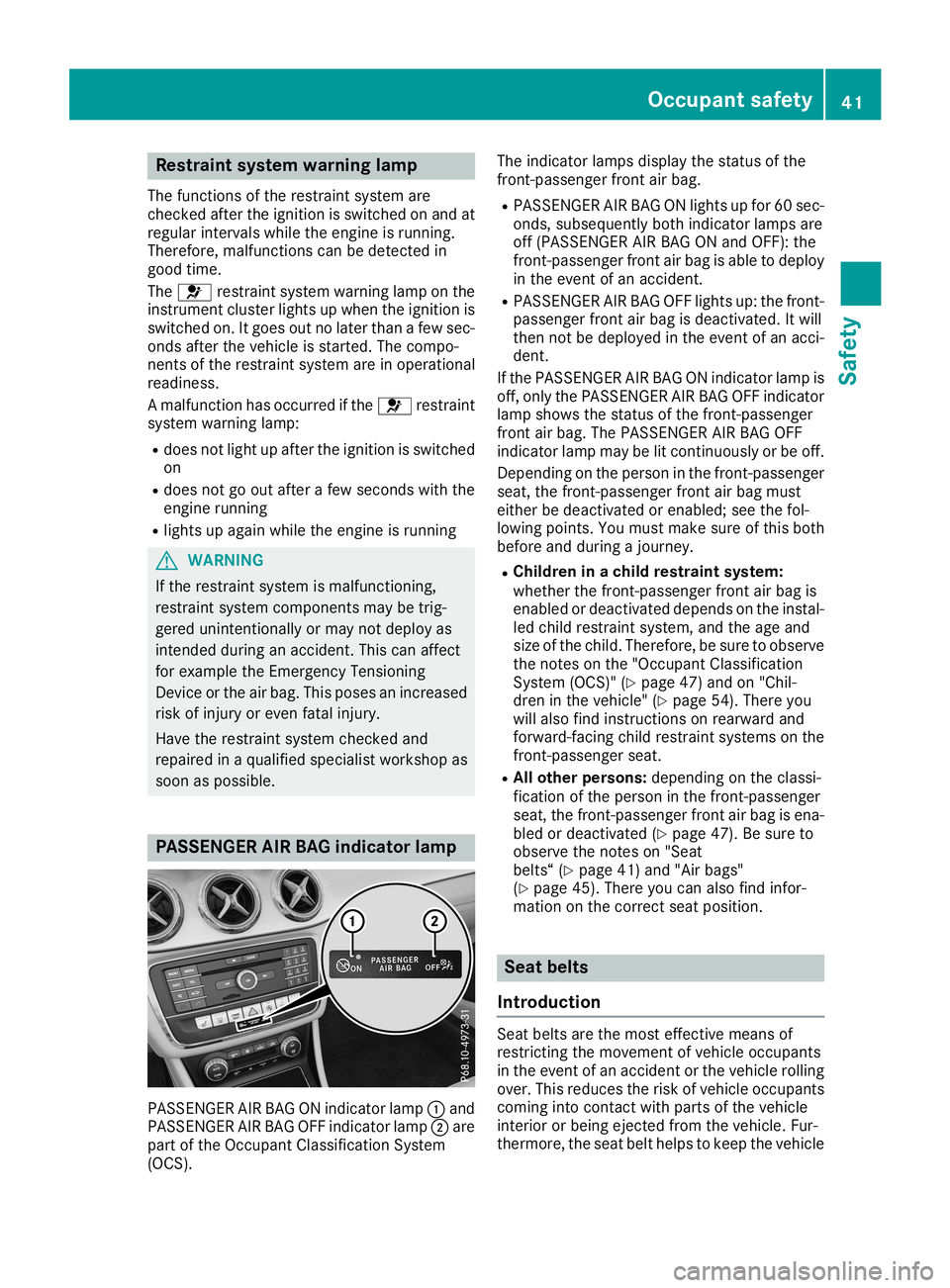
Res
traint system warn inglamp
The functi onsofthe restrai ntsystem are
checke dafte rthe igniti onisswi tched onand at
reg ular inter valswh ile the engi neisrunni ng.
The refo re,mal functi onscanbedete cted in
goo dtime .
The 0075 restrai ntsystem warning lamp onthe
instru mentcluster lights upwhen the igniti onis
swi tched on.Itgoe sou tno later than afew sec-
onds afterthe vehicleis star ted. Thecomp o-
nents ofthe restrai ntsystem areinope rationa l
rea diness .
A mal functi onhasoccu rredifthe 0075 restrai nt
sy stem warning lamp:
R doe snot light upafte rthe igniti onisswi tched
on
R doe snot gooutafte ra few seco ndswith the
engi nerunni ng
R lights upagain wh ile the engi neisrunni ng G
WARNI
NG
If the restrai ntsystem ismal functi oning,
res trai ntsystem components maybetrig -
ger edunintentio nallyor may notdeployas
intend edduring anacci dent. Thiscan affect
for exa mpl ethe Emerg encyTensioning
Devi ceorthe airba g.Thi spos esan incre ased
ris kof inju ryor eve nfata linju ry.
Have therestrai ntsystem checke dand
rep aired inaqu alifi ed spe cialist wo rksho pas
soo nas pos sible. PA
SSE NGER AIRBAG indic ator lamp PASSENG
ERAIR BAG ONindicator lamp 0043and
PASSENG ERAIR BAG OFFindicator lamp 0044are
pa rtof the Occu pant Clas sif ica tion System
(OC S). The
indicator lamps displ aythe statu sof the
front-p asseng erfront airba g.
R PASSENG ERAIR BAG ONlights upfor 60sec-
onds ,su bse quently bothindicator lamps are
off (PASSEN GERAIRBAG ONand OFF) :the
front-p asseng erfront airba gis ab leto dep loy
in the eventofan acci dent.
R PASSENG ERAIR BAG OFFlights up:the front-
pa sse nger front airba gis dea ctiva ted.Itwi ll
then notbedep loye din the eventofan acci -
dent.
If the PASSENG ERAIR BAG ONindicator lamp is
off, only thePASSENG ERAIR BAG OFFindicator
la mp showsthe statu sof the front-p asseng er
front airba g. The PASSENG ERAIR BAG OFF
ind icator lamp may belit continu ously orbe off.
Depe ndingon the person inthe front-p asseng er
sea t,the front-p asseng erfront airba gmus t
ei ther bedea ctiva tedorena bled; see thefol-
lo wi ng points. Youmus tmake sure ofthis both
bef ore and during ajou rney .
R Chi ldre nin achi ldres train tsys tem:
wh ethe rthe front-p asseng erfront airba gis
ena bled ordea ctiva teddep ends onthe insta l-
le d chi ldres trai ntsystem, andtheageand
size ofthe child.The refo re,besure to obs erve
the notes onthe "Occup antClas sif ica tion
Sys tem (OCS)"(Ypage 47)and on"Chil-
dre nin the vehicle" (Y page 54). Thereyou
wi llal so find instr uctions onrea rwa rdand
forw ard-faci ngchildres trai ntsystems onthe
front-p asseng ersea t.
R Allothe rpers ons:dep endi ngon the classi-
fica tion ofthe person inthe front-p asseng er
sea t,the front-p asseng erfront airba gis ena -
bl ed ordea ctiva ted(Ypage 47). Besure to
obs erve thenotes on"Se at
bel ts“ (Ypage 41)and "Airba gs"
(Y page 45).The reyoucan also find infor-
mati ononthe corre ctsea tpos ition. Se
at belts
In troduc tion Sea
tbel tsare the most effective meansof
res tricti ngthe move ment ofveh icleoccu pants
in the eventofan acci dent orthe vehiclerol ling
ove r.Thi sred uce sthe riskof veh icleoccu pants
comi nginto conta ctwith parts ofthe vehicle
inter ioror bei ng ejecte dfrom thevehicle. Fur-
therm ore,the seatbel thel pstokeep thevehicle Oc
cupan tsafe ty
41Safety Z
Page 44 of 330

occupant
inthe best position inrelation tothe
air bag.
The seat beltsystem comprises:
R Seat belts
R Emergen cyTensionin gDevices forthe front
seat belts andtheouter seatbelts inthe rear
R Seat beltforce limiters forthe front seatbelts
and theouter seatbelts inthe rear
If the seat beltispulled outofthe belt outlet
quickly orwith ajerk ymovement ,the belt
retract orlocks. Thebelt strap cannotbe extr ac-
ted any further.
The Emergen cyTensionin gDevice tightensthe
seat beltinan accident ,pulling thebelt close
against thebody. However itdoes notpull the
vehicle occupant backinthe direction ofthe
backrest .
The Emergen cyTensionin gDevice doesnotcor-
rect anincorr ectseat position orthe routing of
an incorr ectlyfastened seatbelt.
When triggered, aseat beltforce limiter helpsto
reduce theforce exertedbythe seat beltonthe
vehicle occupant .
The seat beltforce limiters forthe front seats are
synchron izedwith thefront airbags, which
absorb partofthe deceleration force.Thiscan
reduce theforce exertedon the vehicle occu-
pants during anaccident .
! If
the front -passenger seatisnot occupied,
do not engage theseat belttongue inthe
buckle onthe front -passenger seat.Other-
wise, inthe event ofan accident theEmer-
gency Tensionin gDevice andtheside impact
air bag, inaddition toother systems, maybe
triggered andhave tobe replaced.
Import antsafety notes The
useofseat belts andchild restraint systems
is required bylaw in:
R all 50 states
R the U.S. territ ories
R the Distr ictofColumbia
R all Canadian provinces
Even where thisisnot required bylaw, allvehicle
occupant sshould correctlyfasten theirseat
belts before startingthe journey. G
WARNING
If the seat beltisnot worn correc tly,itcann ot
perform itsinten dedprotect ivefunct ion.An incorr
ectlyfastened seatbeltcanalso cause
injuries, forexample, inthe event ofan acci-
dent orwhen braking orchanging direction
abruptly. Thisposes anincreased riskofinjury
or even fatalinjury.
Always ensurethatallvehicle occupant shave
their seatbelts fastened correctlyand aresit-
ting properly.
The componen tsof the restraint systemworkin
conj unct ionwith each other. Theycanonly
deploy theirprotect ivefunct ionif,at all times, all
vehicle occupant s:
R have fastened theirseatbelts correc tly
(Y page 43)
R have theseat andhead restraint adjusted
properly (Ypage 91) G
WARNING
The seat beltdoes notoffer theinten dedlevel
of protect ionifyou have notmoved theback-
rest toan almost verticalposition. Whenbrak-
ing orinthe event ofan accident ,you could
slide underneath theseat beltandsustain
abdomen orneck injuries, forexample. This
poses anincreased riskofinjury oreven fatal
injury.
Adjust theseat properly beforebeginning
your journey. Alwaysensurethatthebackrest
is in an almost verticalposition andthat the
shoulder sectionofyour seatbeltisrouted
across thecent erofyour shoulder. G
WARNING
Persons lessthan 5ft (1.50 m)tall cann ot
wear theseat beltcorrec tlywithout anaddi-
tional andsuitable restraint system.Ifthe
seat beltisnot worn correc tly,itcann otper-
form itsinten dedprotect ivefunct ion.An
incorr ectlyfastened seatbeltcanalso cause
injuries, forexample, inthe event ofan acci-
dent orwhen braking orchanging direction
abruptly. Thisposes anincreased riskofinjury
or even fatalinjury.
For this reason, alwayssecure persons under
5 ft (1.50 m)tall insuitable additional restraint
systems. 42
Occupant
safetySafety
Page 45 of 330
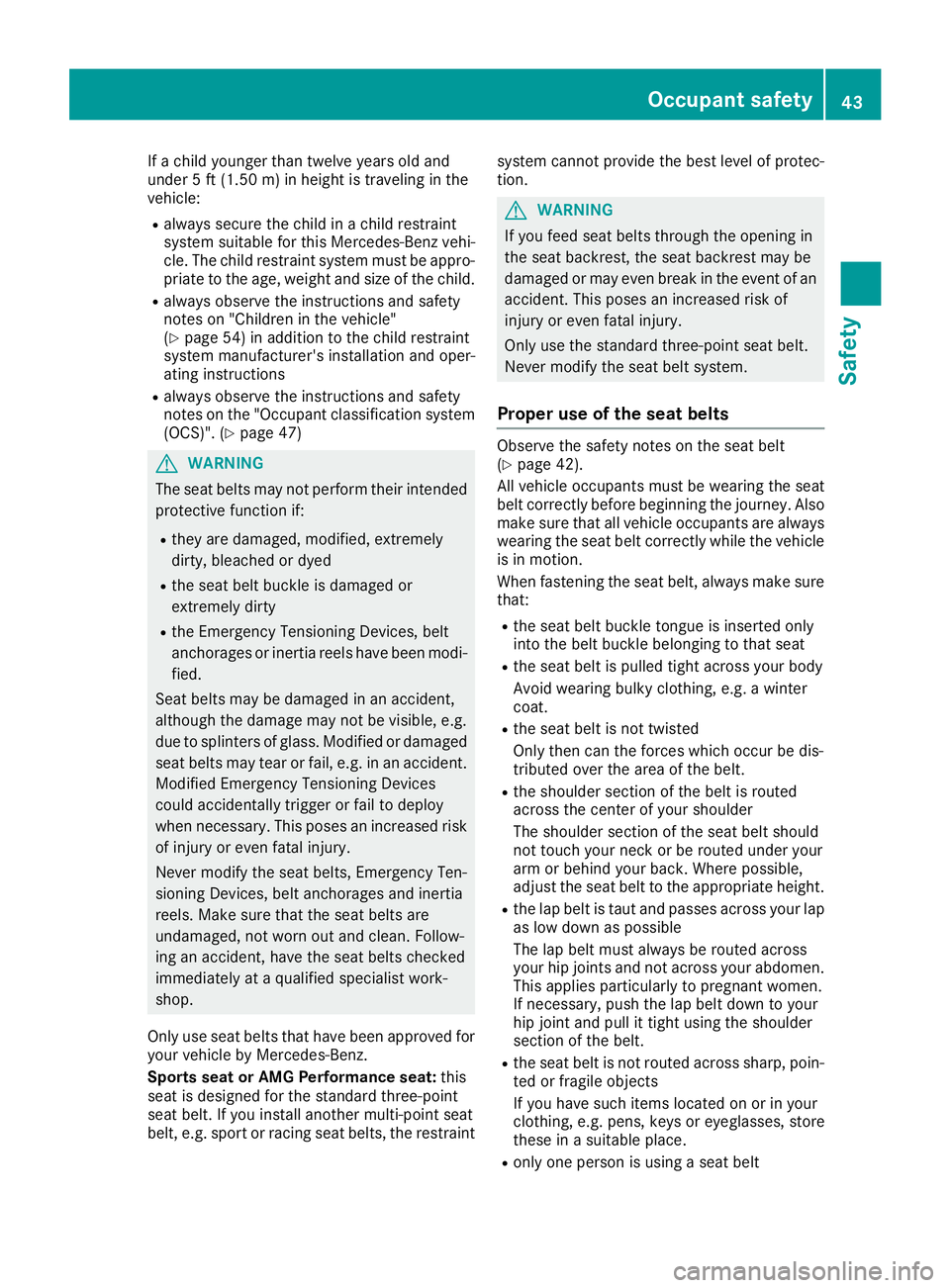
If
achild younger thantwelve yearsold and
under 5ft (1.5 0m) inheight istravelin gin the
vehic le:
R always securethe child inachild restraint
syst emsuitable forthis Merc edes- Benzvehi-
cle. The child restraint systemmust beappro-
priat eto the age, weight andsize ofthe child.
R always observethe instruct ions andsafet y
not eson "Children inthe vehic le"
(Y page 54)inaddition tothe child restraint
syst emmanuf acturer' sinst allation andoper-
atin ginst ruct ions
R always observethe instruct ions andsafet y
not eson the "Occ upant classif icationsyst em
(OCS)". (Ypage 47) G
WARN
ING
The seat belts maynotperf orm theirint ended
prot ective func tion if:
R the yare damaged, modified,extreme ly
dirt y,bleache dor dyed
R the seat beltbuck leisdamaged or
ext reme lydirt y
R the Emergen cyTens ionin gDev ices, belt
anc horage sor iner tiareels havebeen modi-
fied.
Seat belts maybedamaged inan acc ident ,
althoug hthe damage maynotbevisible, e.g.
due tosplint ersofglass. Modifie dor damaged
seat belts maytearorfail, e.g. inan acc ident .
Modifie dEm ergen cyTens ionin gDev ices
could accident allytrigger orfail todeploy
when necessary. Thisposes aninc reased risk
of injury oreven fatalinj ury.
Never modifythe seat belts ,Em ergen cyTen-
sion ingDev ices, beltanchorage sand inertia
reels. Make surethattheseat belts are
undamage d,not worn outand clean .Follow-
ing anacc ident ,have theseat belts checked
immed iatelyataqualified specialist work-
shop.
Only useseat belts thathave been approv edfor
your vehic leby Merc edes- Benz.
Spor tsseat orAMG Performance seat:this
seat isdesign edfor the stan dard three-po int
seat belt. Ifyou installanot hermulti- point seat
belt, e.g.sport orracin gseat belts ,the rest raint syst
emcannot prov idethe best level ofprot ec-
tion . G
WARN
ING
If you feed seatbelts through theopen ingin
the seat backrest,the seat backrestmay be
damaged ormay even break inthe even tof an
acc ident .This poses anincreased riskof
inj ury oreven fatalinj ury.
Only usethestan dard three-po intseat belt.
Never modifythe seat beltsystem.
Prop eruse oftheseat belts Obser
vethe safet ynot eson the seat belt
(Y page 42).
All vehic leocc upant smust bewearin gthe seat
belt correctlybefor ebegin ningthe jour ney. Also
make surethatallvehic leocc upant sare always
wearin gthe seat beltcorrectlywhile thevehic le
is in mot ion.
When fastenin gthe seat belt, always makesure
that :
R the seat beltbuck leton gue isinse rted only
int othe belt buck lebelon gingtothat seat
R the seat beltispulled tightacro ssyour body
Av oid wearin gbulky clothing ,e.g. awint er
coat .
R the seat beltisnot twist ed
Only thencan theforces which occurbe dis-
tr ibuted overthearea ofthe belt.
R the shoulder sectionofthe belt isrout ed
acro ssthe centerofyour shoulder
The shoulder sectionofthe seat beltshould
not touc hyour neckor be rout edunder your
arm orbehin dyour back.Where possible ,
adjust theseat belttothe appropr iateheight .
R the lapbelt istaut andpasses acrossyour lap
as low down aspossible
The lapbelt must always berout edacro ss
your hipjoin tsand notacro ssyour abdomen .
This applies particularly topregn antwomen .
If nec essary, pushthelapbelt down toyour
hip jointand pullittigh tusing theshoulder
sect ionofthe belt.
R the seat beltisnot rout edacro sssharp, poin-
ted orfragile objects
If you have such itemslocat edon orinyour
clot hing ,e.g. pens ,keys oreyeglasses ,sto re
the seinasuitable place.
R only oneperso nis using aseat belt Occupa
ntsaf ety
43Safety Z
Page 46 of 330
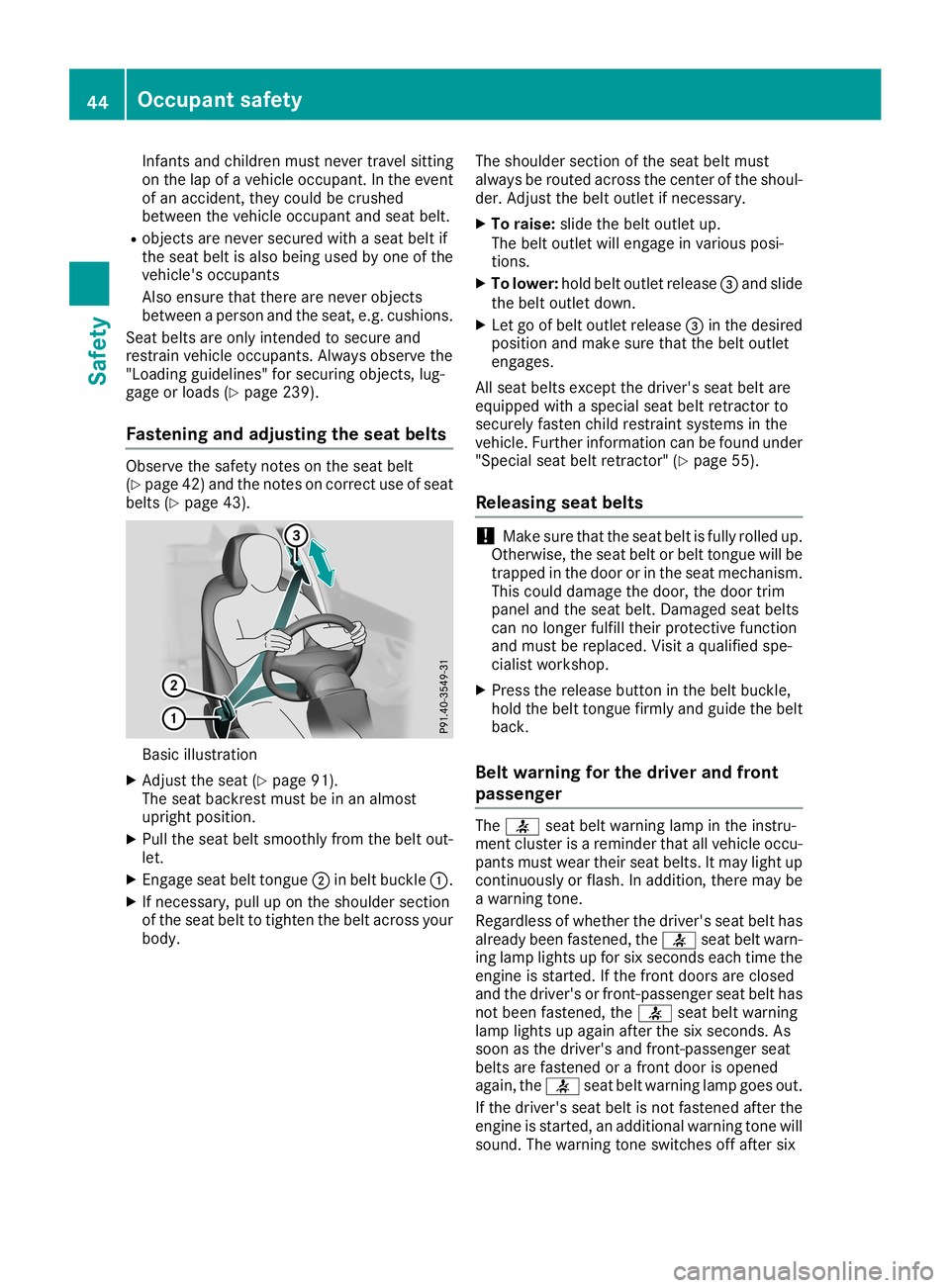
Infants
andchildre nmust never travel sitting
on the lapofavehicle occupant. Inthe event
of an accident, theycould becrushed
betwee nthe vehicle occupant andseat belt.
R objects arenever secured withaseat beltif
the seat beltisalso being usedbyone ofthe
vehicle 'soccupants
Also ensure thatthere arenever objects
betwee naperson andtheseat, e.g.cushio ns.
Seat belts areonly intended tosecure and
restrain vehicleoccupants. Alwaysobserve the
"Loa ding guidelines" forsecuring objects,lug-
gage orload s(Y page 239).
Fasteni ngand adjusting theseat belts Observe
thesafety notesonthe seat belt
(Y page 42)and thenotes oncorrect useofseat
belts (Ypage 43). Basic
illustration
X Adjust theseat (Ypage 91).
The seat backrest mustbeinan almos t
upri ghtpositio n.
X Pul lthe seat beltsmoothly fromthebelt out-
let.
X Engage seatbelttongue 0044inbelt buckle 0043.
X Ifnecessary ,pul lup on the shoul dersection
of the seat belttotighten thebelt across your
body . The
shoul dersection ofthe seat beltmust
alw ays berouted across thecenter ofthe shoul -
der. Adjust thebelt outlet ifnecessary .
X To raise: slidethe belt outlet up.
The belt outlet willengage invariou sposi-
tions.
X To low er:hold beltoutlet release0087 and slide
the belt outlet down.
X Let goofbelt outlet release0087 inthe desire d
positio nand make surethatthebelt outlet
engages .
All seat belts except thedriver's seatbeltare
equi pped withaspecia lseat beltretractor to
securel yfasten childrestraint systemsinthe
vehicle .Further information canbefound under
"Specia lseat beltretractor" (Ypage 55).
Releas ingseat belts !
Make
surethattheseat beltisfull yrolle dup.
Otherwise ,the seat beltorbelt tongue willbe
trapped inthe door orinthe seat mechanism.
This could damagethe door, thedoor trim
panel andtheseat belt. Damaged seatbelts
can nolonger fulfilltheir protective function
and must berepla ced.Visit aqua lifiedspe-
ciali stworkshop.
X Press therelea sebutton inthe belt buckle,
hold thebelt tongue firmlyandguide the belt
back.
Belt warning forthe driver andfront
passeng er The
0076 seatbeltwarning lampinthe instru-
ment cluster isareminder thatallvehicle occu-
pants mustweartheir seatbelts. Itmay light up
continuously orflash. Inaddi tion, there maybe
a warning tone.
Rega rdless ofwhether thedriver's seatbelthas
alrea dybeen fastened, the0076 seatbeltwarn-
ing lamp lights upfor sixseconds eachtimethe
engine isstarted. Ifthe front doors areclosed
and thedriver's orfront-passenger seatbelthas
not been fastened, the0076 seatbeltwarning
lamp lightsup aga inafter thesixseconds. As
soon asthe driver's andfront-passenger seat
belts arefastened orafront doorisopened
aga in,the 0076 seatbeltwarning lampgoesout.
If the driver's seatbeltisnot fastened afterthe
engine isstarted, anaddi tional warning tonewill
sound. Thewarning toneswitches offafter six 44
Occ
upant safetySafety
Page 47 of 330
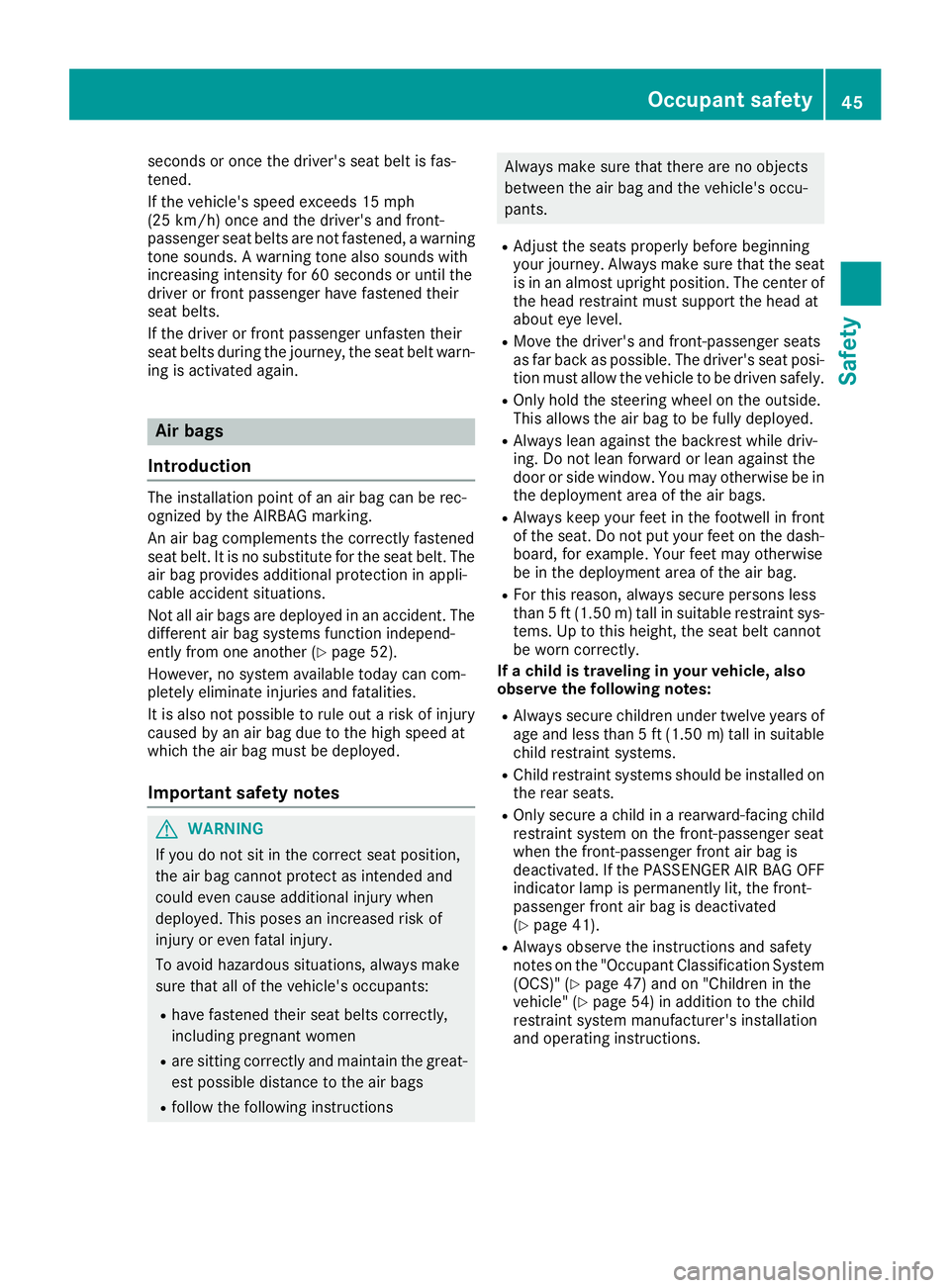
seconds
oronce thedriver's seatbeltisfas-
tened.
If the vehicle's speedexceeds 15mph
(25 km/h) onceandthedriver's andfront -
passenger seatbelts arenot fastened, awarning
tone sounds. Awarning tonealsosounds with
increasing intensityfor 60seconds oruntil the
driver orfront passenger havefastened their
seat belts.
If the driver orfront passenger unfastentheir
seat belts during thejourney, theseat beltwarn-
ing isactivated again. Air
bags
Introduction The
installation pointofan air bag canberec-
ognized bythe AIRBAG marking.
An airbag complements thecorrect lyfastened
seat belt. Itis no substitute forthe seat belt. The
air bag provides additional protection inappli -
cable accident situations.
Not allair bags aredeploy edinan accident. The
different airbag systems functionindepend-
ently fromoneanother (Ypage 52).
However, nosystem available today cancom-
pletely eliminate injuriesandfatalities.
It is also notpossible torule outarisk ofinjury
caused byan air bag due tothe high speed at
which theairbag must bedeploy ed.
Importa ntsafety notes G
WARNING
If you donot sitinthe correct seatposition,
the airbag cannot protect asintended and
could evencause additional injurywhen
deploy ed.This poses anincreased riskof
injury oreven fatalinjury.
To avoid hazardous situations, alwaysmake
sure thatallofthe vehicle's occupants:
R have fastened theirseatbelts correct ly,
including pregnantwomen
R are sitting correct lyand maintain thegreat-
est possible distance tothe airbags
R follow thefollowi nginstruct ions Always
makesurethatthere arenoobjects
between theairbag and thevehicle's occu-
pants.
R Adjust theseats properly beforebeginning
your journey. Alwaysmakesurethattheseat
is in an almost upright position. Thecenter of
the head restraint mustsupport thehead at
about eyelevel.
R Move thedriver's andfront -passenger seats
as far back aspossible .The driver's seatposi-
tion must allow thevehicle tobe driven safely.
R Only holdthesteering wheelonthe outside.
This allow sthe airbag tobe fully deploy ed.
R Always leanagainstthe backrest whiledriv-
ing. Donot lean forward orlean againstthe
door orside window. Youmay otherwise bein
the deploy mentareaofthe airbags.
R Always keepyourfeetinthe footwell infront
of the seat. Donot putyour feetonthe dash-
board, forexample. Yourfeetmay otherwise
be inthe deploy mentareaofthe airbag.
R For this reason, alwayssecure persons less
than 5ft (1.50 m)tall insuitable restraint sys-
tems. Uptothis height, theseat beltcannot
be worn correct ly.
If achild istra veling inyour vehicle ,also
observe thefollow ingnotes:
R Always securechildren undertwelve yearsof
age and less than 5ft (1.50 m)tallin suita ble
chi ldres traint syste ms.
R Ch ild res traint syste ms sho uldbe installedon
the rearse ats .
R Onl yse cur eachi ldinarea rward-fa cing child
res traint syste mon the front-pa ssenge rse at
wh en the front-pa ssenge rfro ntairba gis
de acti vated .If the PASSEN GERAIRBAG OFF
ind icator lamp ispe rma nentl ylit, the front-
pa sse nge rfro ntairba gis de acti vated
(Y page 41) .
R Alw aysob serve the instructio nsand safety
note son the "Occu pantClas sific ati on Sys tem
(O CS) "(Y page 47) and on"Child ren inthe
veh icle" (Y page 54)in ad ditio nto the child
res traint syste mma nuf actu rer'sins tallatio n
and opera ting instructio ns. Oc
cupant safety
45Safety Z
Page 48 of 330
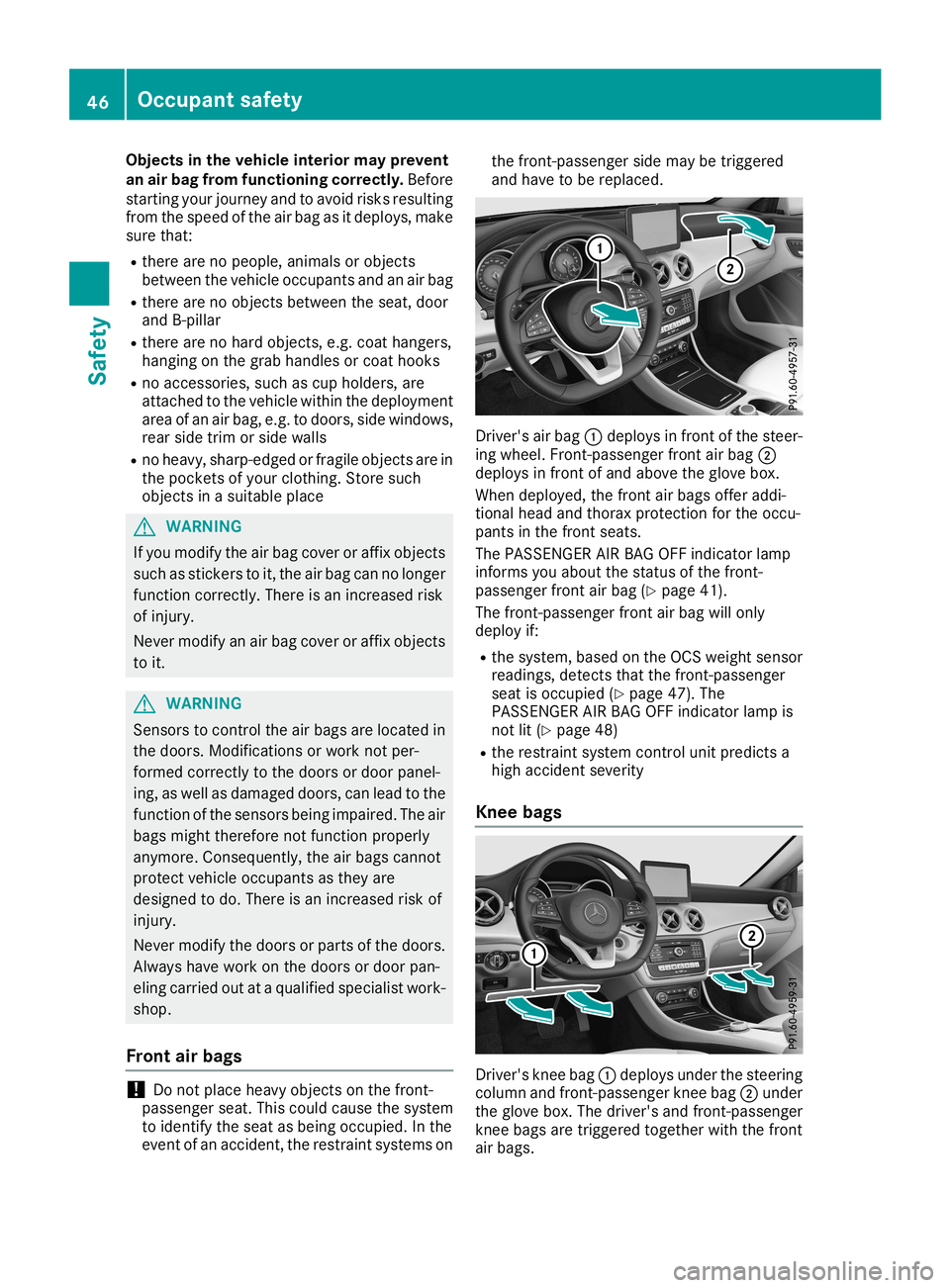
Objects
inthe vehicle interior mayprevent
an air bag from functioning correctly.Before
start ingyour journ eyand toavoid risksresulting
from thespeed ofthe airbag asitdeploys, make
sure that:
R there arenopeople, animals orobject s
between thevehicle occupant sand anair bag
R there arenoobject sbetween theseat, door
and B-pillar
R there arenohard object s,e.g. coat hangers,
hanging onthe grab handles orcoat hooks
R no accessor ies,such ascup holders, are
attac hedtothe vehicle withinthedeployment
area ofan air bag, e.g.todoors, sidewindows,
rear side trimorside walls
R no heavy, sharp-edged orfragile objectsare in
the pocket sof your clothing.Store such
object sin asuitable place G
WARNIN
G
If you modify theairbag cover oraffix object s
such asstick erstoit,the airbag cannolonger
funct ioncorr ectly. There isan incr eased risk
of injury.
Never modify anair bag cover oraffix object s
to it. G
WARNIN
G
Sens orstocont rolthe airbags arelocated in
the doors. Modification sor work notper-
formed correctly tothe doors ordoor panel-
ing, aswell asdamaged doors,canlead tothe
funct ionofthe sensor sbeing impaired. Theair
bags might thereforenot funct ionproperly
anymore. Consequent ly,the airbags cannot
protec tvehicle occupant sas they are
designed todo. There isan incr eased riskof
injury.
Never modify thedoors orparts ofthe doors.
Always havework onthe doors ordoor pan-
eling carried outataqualified specialist work-
shop.
Front airbags !
Do
not place heavy objectson the fron t-
passenger seat.Thiscould cause thesystem
to identif ythe seat asbeing occupied. Inthe
event ofan accident ,the restr aintsystems onthe
fron t-passenger sidemay betrigger ed
and have tobe replaced. Driver
'sair bag 0043deploys infron tof the steer-
ing wheel. Front-passenger frontair bag 0044
deploys infron tof and above theglove box.
When deployed, thefron tair bags offeraddi-
tional headandthorax protectionforthe occu-
pants inthe fron tseats.
The PASSENGER AIRBAG OFFindicato rlamp
inform syou about thestatusofthe fron t-
passenger frontair bag (Ypage 41).
The front-passenger frontair bag willonly
deploy if:
R the system, basedonthe OCS weight sensor
readings, detectsthat thefron t-passenger
seat isoccupied (Ypage 47).The
PAS SENGER AIRBAG OFFindicato rlamp is
not lit(Y page 48)
R the restr aintsystem controlunit predict sa
high accident severity
Knee bags Driver
'skn ee bag 0043deploys underthesteerin g
column andfront-passenger knee bag 0044under
the glove box.Thedriver's andfront-passenger
kn ee bags aretrigger edtoget herwith thefron t
air bags. 46
Occupant
safetySafety
Page 49 of 330
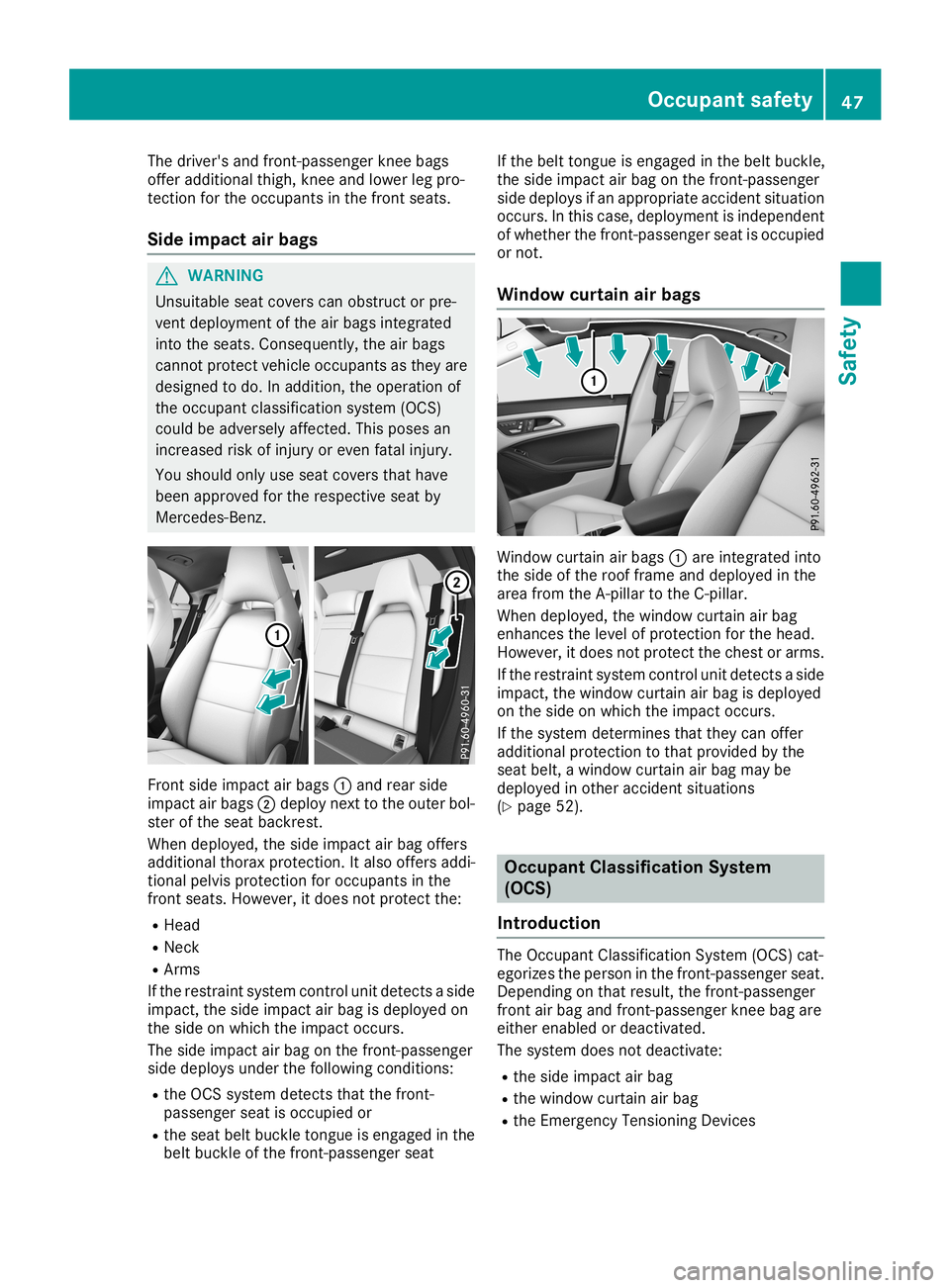
The
driver's andfront -passenger kneebags
offer additional thigh,kneeandlower legpro-
tect ionforthe occupant sin the front seats.
Side impa ctair bags G
WARNIN
G
Unsuitable seatcovers canobstruct orpre-
vent deployment ofthe airbags integr ated
into theseats. Consequently, theairbags
cann otprotec tvehicle occupant sas they are
designed todo. Inaddition, theoperation of
the occupant classification system(OCS)
could beadversely affected.This poses an
increased riskofinjury oreven fatalinjury.
You should onlyuseseat covers thathave
been approved forthe respect iveseat by
Mercedes- Benz. Fron
tside impact airbags 0043and rear side
impact airbags 0044deploy nexttothe outer bol-
ster ofthe seat backrest .
When deployed, theside impact airbag offers
additional thoraxprotection.Italso offers addi-
tional pelvis protec tionforoccupant sin the
front seats. However, itdoes notprotec tthe:
R Head
R Neck
R Arms
If the restr aintsystem controlunit detect sa side
impact, theside impact airbag isdeployed on
the side onwhich theimpact occurs.
The side impact airbag onthe front -passenger
side deploys underthefollowing conditions:
R the OCS system detectsthat thefront -
passenger seatisoccupied or
R the seat beltbuckle tongue isengaged inthe
belt buckle ofthe front -passenger seat If
the belt tongue isengaged inthe belt buckle,
the side impact airbag onthe front -passenger
side deploys ifan appropriate accidentsituation
occurs. Inthis case, deployment isindependent
of whether thefront -passenger seatisoccupied
or not .
Window curtainairbags Window
curtainairbags 0043are integr atedinto
the side ofthe roof frame anddeployed inthe
area from theA-pillar tothe C-pillar.
When deployed, thewindow curtainairbag
enhanc esthe level ofprotec tionforthe head.
However, itdoes notprotec tthe chest orarms.
If the restr aintsystem controlunit detect sa side
impact, thewindow curtainairbag isdeployed
on the side onwhich theimpact occurs.
If the system determin esthat they canoffer
additional protectiontothat provided bythe
seat belt, awindow curtainairbag may be
deployed inother accident situations
(Y page 52). Occupant
Classification System
(OCS)
Introdu ction The
Occupant Classification System(OCS)cat-
egorizes theperson inthe front -passenger seat.
Dependin gon that result, thefront -passenger
front airbag and front -passenger kneebagare
either enabled ordeactivated.
The system doesnotdeactivate:
R the side impact airbag
R the window curtainairbag
R the Emergen cyTensionin gDevices Occupant
safety
47Safety Z
Page 50 of 330
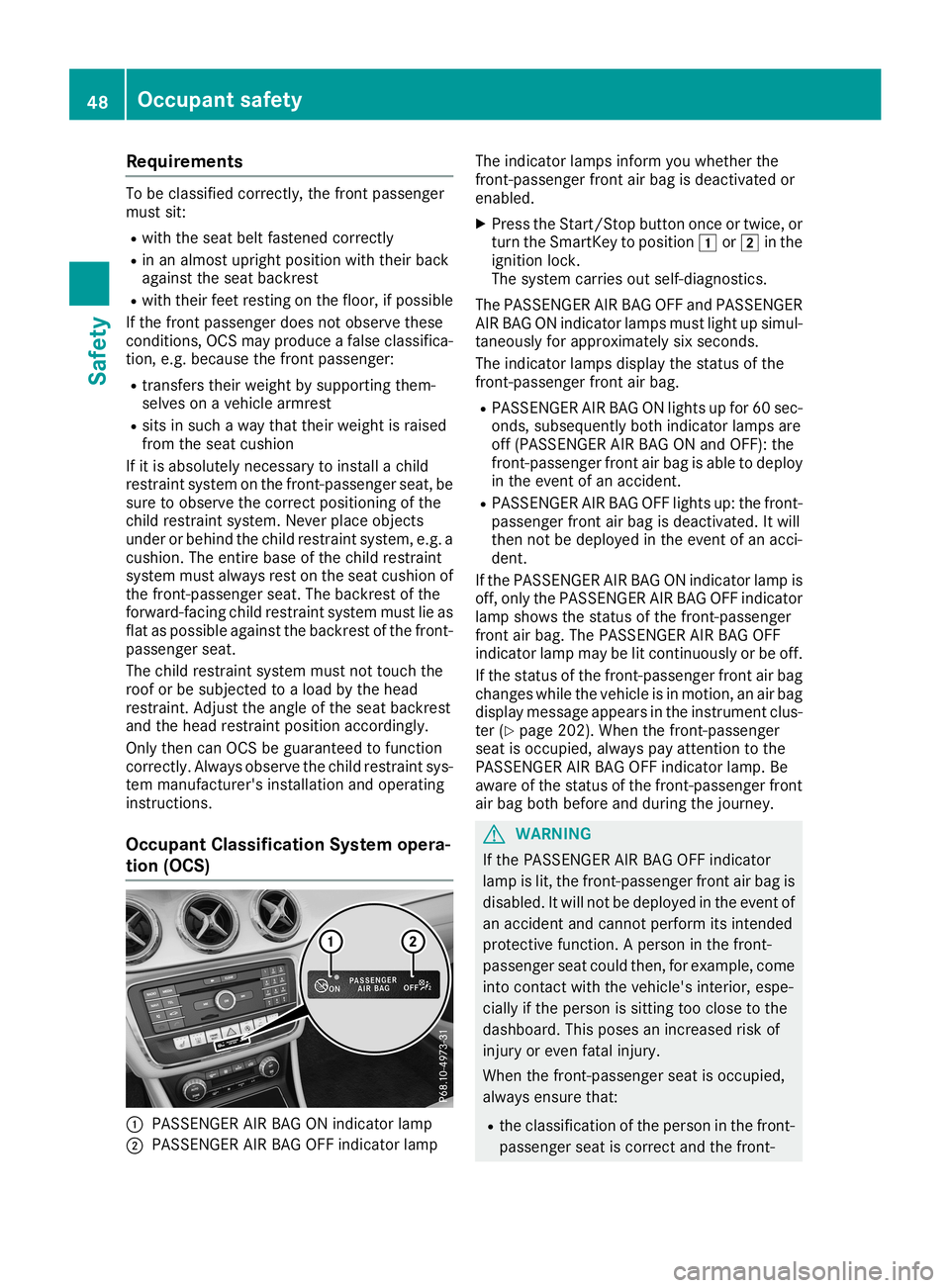
Requi
rements To
be classifiedcorre ctly,the front passe nger
mus tsit:
R with the seatbel tfas tened correctly
R in an almost uprig ht pos ition with thei rba ck
ag ainst the seatba ckrest
R with thei rfee tres ting onthe floor, ifpos sible
If the front passe nger doesnot observe these
condi tions,OC Smay produce afal se cla ssifica -
tion, e.g.because the front passe nger :
R trans ferstheirwe ight by supp orti ngthem-
sel ves onaveh iclearm rest
R sits insuch awa ythat theirwe ight israi sed
from theseatcus hion
If it is ab sol ute lyneces sary to insta lla chi ld
res trai ntsystem onthe front-p asseng ersea t,be
su re to obs erve thecorre ctpos itioning ofthe
chi ldres trai ntsystem. Neverpl ace obje cts
und eror beh indthe childres trai ntsystem, e.g.a
cus hion.The entir eba se ofthe childres trai nt
sy stem mustal wa ysres ton the seatcus hionof
the front-p asseng ersea t.The backrest ofthe
forw ard-faci ngchi ldres trai ntsystem mustlie as
fla tas pos sibleag ainst the backrest ofthe front-
pa sse nger seat.
The childres trai ntsystem mustnot touchthe
roo for be subjecte dto aload bythe head
res trai nt.Adju stthe angleof the seatba ckrest
and theheadres trai ntpos ition acco rdingly .
Only thencanOCSbe guara nteed tofuncti on
corre ctly.Alw aysobs erve thechildres trai ntsys-
tem manu facturer'sinsta llati on and operating
instru ctions .
Oc cupa ntClass ificati onSys tem opera-
tio n(O CS ) 0043
PASSENG ERAIR BAG ONindicator lamp
0044 PASSENG ERAIR BAG OFFindicator lamp The
indicator lamps informyouwh ethe rthe
front-p asseng erfront airba gis dea ctiva tedor
ena bled.
X Pre ssthe Start/Sto pbu tton once ortwi ce, or
turn theSmar tKeytopos ition 0047 or0048 inthe
ig niti onlock.
The system carriesou tsel f-di agnosti cs.
The PASSENG ERAIR BAG OFFandPASSENG ER
AIR BAG ONindicator lamps mustlight upsim ul-
tane ously for appro xima telysixseco nds.
The indicator lamps displ aythe statu sof the
front-p asseng erfront airba g.
R PASSENG ERAIR BAG ONlights upfor 60sec-
onds ,su bse quently bothindicator lamps are
off (PASSEN GERAIRBAG ONand OFF) :the
front-p asseng erfront airba gis ab leto dep loy
in the eventofan acci dent.
R PASSENG ERAIR BAG OFFlights up:the front-
pa sse nger front airba gis dea ctiva ted.Itwi ll
then notbedep loye din the eventofan acci -
dent.
If the PASSENG ERAIR BAG ONindicator lamp is
off, only thePASSENG ERAIR BAG OFFindicator
la mp showsthe statu sof the front-p asseng er
front airba g. The PASSENG ERAIR BAG OFF
ind icator lamp may belit continu ously orbe off.
If the statu sof the front-p asseng erfront airba g
cha nges while the vehicleis in moti on,anairba g
di spl aymes sage appea rsinthe instr umentclu s-
ter (Ypage 202). Whenthe front-p asseng er
sea tis occu pied, alwa yspayattenti ontothe
PASSENG ERAIR BAG OFFindicator lamp. Be
aw are ofthe statu sof the front-p asseng erfront
ai rba gboth before and during thejourney . G
WARNI
NG
If the PASSENG ERAIR BAG OFFindicator
la mp islit, the front-p asseng erfront airba gis
di sa bled. Itwi llnot bedep loye din the eventof
an acci dent andcanno tper form itsintend ed
pro tectiv efuncti on.Aper son inthe front-
pa sse nger seatcou ldthen, forexa mpl e,come
into conta ctwith the vehicle's inter ior, esp e-
cia lly if the person issitti ngtoo closetothe
da shb oard. Thispos esan incre ased riskof
inju ryor eve nfata linju ry.
Whe nthe front-p asseng ersea tis occu pied,
al wa ysensu rethat:
R the classifica tion ofthe person inthe front-
pa sse nger seatis corre ctand thefront- 48
Oc
cupan tsafe tySafe ty